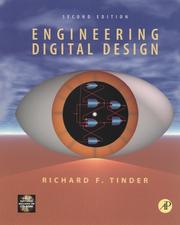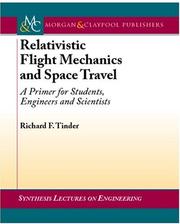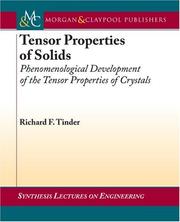| Listing 1 - 8 of 8 |
Sort by
|

ISBN: 1281028282 9786611028282 0080505651 0126912955 Year: 2000 Publisher: San Diego : Academic Press,
Abstract | Keywords | Export | Availability | Bookmark
 Loading...
Loading...Choose an application
- Reference Manager
- EndNote
- RefWorks (Direct export to RefWorks)
Engineering Digital Design, Second Edition provides the most extensive coverage of any available textbook in digital logic and design. The new REVISED Second Edition published in September of 2002 provides 5 productivity tools free on the accompanying CD ROM. This software is also included on the Instructor's Manual CD ROM and complete instructions accompany each software program.In the REVISED Second Edition modern notation combines with state-of-the-art treatment of the most important subjects in digital design to provide the student with the background needed to ente
Digital electronics. --- Logic design. --- Design, Logic --- Design of logic systems --- Digital circuits --- Digital techniques (Electronics) --- Digital electronics --- Electronic circuit design --- Logic circuits --- Machine theory --- Switching theory --- Electronic systems --- Electronics --- Logic design

ISBN: 0126912955 9780126912951 1281028282 9781281028280 9786611028282 6611028285 0080505651 9780080505657 0585470480 9780585470481 Year: 2000 Publisher: San Diego Academic Press
Abstract | Keywords | Export | Availability | Bookmark
 Loading...
Loading...Choose an application
- Reference Manager
- EndNote
- RefWorks (Direct export to RefWorks)
Production management --- Computer. Automation --- engineering --- computers --- Digital electronics --- Logic design --- digitale techniek --- pld (programmable logic devices) --- Design, Logic --- Design of logic systems --- Electronic circuit design --- Logic circuits --- Machine theory --- Switching theory --- Digital circuits --- Digital techniques (Electronics) --- Electronic systems --- Electronics

ISBN: 1598291319 9781598291315 1598291300 9781598291308 Year: 2007 Publisher: San Rafael, Calif. (1537 Fourth Street, San Rafael, CA 94901 USA) : Morgan & Claypool Publishers,
Abstract | Keywords | Export | Availability | Bookmark
 Loading...
Loading...Choose an application
- Reference Manager
- EndNote
- RefWorks (Direct export to RefWorks)
Relativistic Flight Mechanics and Space Travel is about the fascinating prospect of future human space travel. Its purpose is to demonstrate that such ventures may not be as difficult as one might believe and are certainly not impossible. The foundations for relativistic flight mechanics are provided in a clear and instructive manner by using well established principles which are used to explore space flight possibilities within and beyond our galaxy. The main substance of the book begins with a background review of Einstein's Special Theory of Relativity as it pertains to relativistic flight mechanics and space travel. The book explores the dynamics and kinematics of relativistic space flight from the point of view of the astronauts in the spacecraft and compares these with those observed by earth's scientists and engineers--differences that are quite surprising. A quasi historical treatment leads quite naturally into the central subject areas of the book where attention is focused on various issues not ordinarily covered by such treatment. To accomplish this, numerous simple thought experiments are used to bring rather complicated subject matter down to a level easily understood by most readers with an engineering or science background. The primary subjects regarding photon rocketry and space travel are covered in some depth and include a flight plan together with numerous calculations represented in graphical form. A geometric treatment of relativistic effects by using Minkowski diagrams is included for completeness. The book concludes with brief discussions of other prospective, even exotic, transport systems for relativistic space travel. A glossary and simple end-of-chapter problems with answers enhance the learning process.
Manned space flight. --- Relativistic rocket mechanics. --- Relativistic rockets --- Rocket. --- Photon. --- Flight. --- Relativity. --- Mechanics. --- Space. --- Astronauts. --- Exploration. --- Star. --- Galaxy. --- Einstein. --- Minkowski. --- Astronautics --- Relativistic mechanics --- Relativity (Physics) --- Rockets (Aeronautics) --- Space flight --- Astronauts --- Space ships

ISBN: 1598293494 9781598293494 1598293486 9781598293487 9781598295740 Year: 2008 Publisher: San Rafael, Calif. (1537 Fourth Street, San Rafael, CA 94901 USA) Morgan & Claypool Publishers
Abstract | Keywords | Export | Availability | Bookmark
 Loading...
Loading...Choose an application
- Reference Manager
- EndNote
- RefWorks (Direct export to RefWorks)
Book
ISBN: 9781598296907 9781598296891 Year: 2009 Publisher: San Rafael, Calif. (1537 Fourth Street, San Rafael, CA 94901 USA) Morgan & Claypool Publishers
Abstract | Keywords | Export | Availability | Bookmark
 Loading...
Loading...Choose an application
- Reference Manager
- EndNote
- RefWorks (Direct export to RefWorks)

ISBN: 0126912955 9780126912951 1281028282 9781281028280 9786611028282 6611028285 0080505651 9780080505657 Year: 2000 Publisher: San Francisco, Calif. Academic Press
Abstract | Keywords | Export | Availability | Bookmark
 Loading...
Loading...Choose an application
- Reference Manager
- EndNote
- RefWorks (Direct export to RefWorks)
Engineering Digital Design, Second Edition provides the most extensive coverage of any available textbook in digital logic and design. The new REVISED Second Edition published in September of 2002 provides 5 productivity tools free on the accompanying CD ROM. This software is also included on the Instructor's Manual CD ROM and complete instructions accompany each software program. In the REVISED Second Edition modern notation combines with state-of-the-art treatment of the most important subjects in digital design to provide the student with the background needed to enter industry or graduate study at a competitive level. Combinatorial logic design and synchronous and asynchronous sequential machine design methods are given equal weight, and new ideas and design approaches are explored. The productivity tools provided on the accompanying CD are outlined below: [1] EXL-Sim2002 logic simulator: EXL-Sim2002 is a full-featured, interactive, schematic-capture and simulation program that is ideally suited for use with the text at either the entry or advanced-level of logic design. Its many features include drag-and-drop capability, rubber banding, mixed logic and positive logic simulations, macro generation, individual and global (or randomized) delay assignments, connection features that eliminate the need for wire connections, schematic page sizing and zooming, waveform zooming and scrolling, a variety of printout capabilities, and a host of other useful features. [2] BOOZER logic minimizer: BOOZER is a software minimization tool that is recommended for use with the text. It accepts entered variable (EV) or canonical (1's and 0's) data from K-maps or truth tables, with or without don't cares, and returns an optimal or near optimal single or multi-output solution. It can handle up to 12 functions Boolean functions and as many inputs when used on modern computers. [3] ESPRESSO II logic minimizer: ESPRESSO II is another software minimization tool widely used in schools and industry. It supports advanced heuristic algorithms for minimization of two-level, multi-output Boolean functions but does not accept entered variables. It is also readily available from the University of California, Berkeley, 1986 VLSI Tools Distribution. [4] ADAM design software: ADAM (for Automated Design of Asynchronous Machines) is a very powerful productivity tool that permits the automated design of very complex asynchronous state machines, all free of timing defects. The input files are state tables for the desired state machines. The output files are given in the Berkeley format appropriate for directly programming PLAs. ADAM also allows the designer to design synchronous state machines, timing-defect-free. The options include the lumped path delay (LPD) model or NESTED CELL model for asynchronous FSM designs, and the use of D FLIP-FLOPs for synchronous FSM designs. The background for the use of ADAM is covered in Chapters 11, 14 and 16 of the REVISED 2nd Edition. [5] A-OPS design software: A-OPS (for Asynchronous One-hot Programmable Sequencers) is another very powerful productivity tool that permits the design of asynchronous and synchronous state machines by using a programmable sequencer kernel. This software generates a PLA or PAL output file (in Berkeley format) or the VHDL code for the automated timing-defect-free designs of the following: (a) Any 1-Hot programmable sequencer up to 10 states. (b) The 1-Hot design of multiple asynchronous or synchronous state machines driven by either PLDs or RAM. The input file is that of a state table for the desired state machine. This software can be used to design systems with the capability of instantly switching between several radically different controllers on a time-shared basis. The background for the use of A-OPS is covered in Chapters 13, 14 and 16 of the REVISED 2nd Edition. The above software, as bundled with the REVISED 2nd Edition, will be unique and highly useful to students and faculty alike for both instructional and research purposes. All of the above software, except the EXL-Sim2002 simulator, require the use of a text editor. A "Slideshow" and a "Software Overview" are also included on the CD ROM to provide additional information regarding these productivity tools and the many other new and unique features found in Engineering Digital Design REVISED Second Edition). Other new features found in the REVISED Second Edition include numerous new end-of-chapter problems that have been added to enrich the student's learning experience by making use of the software tools listed above. After inspecting the REVISED Second Edition and using the software bundled with it readers will find a fresh new approach to logic design and analysis has been introduced. The text is designed to be used at the entry, intermediate or advanced levels thereby making it unnecessary for students to change texts between successive courses in the subject area. * CD-ROM bundled with text includes 5 powerful productivity tools free * The most complete coverage of any text in digital logic and design * Appropriate for introductory and intermediate courses in digital logic and design * Over 670 figures and tables help to replace lengthy explanations * More than 1000 worked and unworked exercises and problems aid the learning process * Unique coverage of ALUs * Extensive coverage of number systems, binary arithmetic and codes * Exceptionally strong in synchronous and asynchronous machine design * Extensive glossary presented at the beginning of the text.
Production management --- Computer. Automation --- engineering --- computers
Book
Year: 2007 Publisher: [San Rafael] : Morgan & Claypool Publishers,
Abstract | Keywords | Export | Availability | Bookmark
 Loading...
Loading...Choose an application
- Reference Manager
- EndNote
- RefWorks (Direct export to RefWorks)
Tensor Properties of Solids presents the phenomenological development of solid state properties represented as matter tensors in two parts: Part I on equilibrium tensor properties and Part II on transport tensor properties.Part I begins with an introduction to tensor notation, transformations, algebra, and calculus together with the matrix representations. Crystallography, as it relates to tensor properties of crystals, completes the background treatment. A generalized treatment of solid-state equilibrium thermodynamics leads to the systematic correlation of equilibrium tensor properties. This
Crystallography, Mathematical. --- Calculus of tensors. --- Thermodynamics. --- Transport theory.
Book
ISBN: 3031793064 Year: 2007 Publisher: Cham : Springer International Publishing : Imprint: Springer,
Abstract | Keywords | Export | Availability | Bookmark
 Loading...
Loading...Choose an application
- Reference Manager
- EndNote
- RefWorks (Direct export to RefWorks)
Tensor Properties of Solids presents the phenomenological development of solid state properties represented as matter tensors in two parts: Part I on equilibrium tensor properties and Part II on transport tensor properties. Part I begins with an introduction to tensor notation, transformations, algebra, and calculus together with the matrix representations. Crystallography, as it relates to tensor properties of crystals, completes the background treatment. A generalized treatment of solid-state equilibrium thermodynamics leads to the systematic correlation of equilibrium tensor properties. This is followed by developments covering first-, second-, third-, and higher-order tensor effects. Included are the generalized compliance and rigidity matrices for first-order tensor properties, Maxwell relations, effect of measurement conditions, and the dependent coupled effects and use of interaction diagrams. Part I concludes with the second- and higher-order effects, including numerous optical tensor properties. Part II presents the driving forces and fluxes for the well-known proper conductivities. An introduction to irreversible thermodynamics includes the concepts of microscopic reversibility, Onsager's reciprocity principle, entropy density production, and the proper choice of the transport parameters. This is followed by the force-flux equations for electronic charge and heat flow and the relationships between the proper conductivities and phenomenological coefficients. The thermoelectric effects in solids are discussed and extended to the piezothermoelectric and piezoresistance tensor effects. The subjects of thermomagnetic, galvanomagnetic, and thermogalvanomagnetic effects are developed together with other higher-order magnetotransport property tensors. A glossary of terms, expressions, and symbols are provided at the end of the text, and end-of-chapter problems are provided on request. Endnotes provide the necessary references for further reading. Table of Contents: I. Equilibrium Tensor Properties of Solids / Introduction / Introduction to Tensor Notation, Tensor Transformations, Tensor Calculus, and Matrix Representation / Crystal Systems, Symmetry Elements, and Symmetry Transformations / Generalized Thermostatics and the Systematic Correlation of Physical Properties / The Dependent Coupled Effects and the Interrelationships Between First-Order Tensor Properties - Use of Interaction Diagrams / Third- and Fourth-Rank Tensor Properties - Symmetry Considerations / Second- and Higher-Order Effects - Symmetry Considerations / II. Transport Properties of Solids / Introduction to Transport Properties and the Thermodynamics of Irreversible Processes / Thermoelectric, Piezothermoelectric, and Diffusive Effects in Solids / Effect of Magnetic Field on the Transport Properties / Appendix A: Magnetic Tensor Properties, Magnetic Crystals, and the Combined Space-Time Transformations / Endnotes / Glossary / Biography / Index.
Engineering design. --- Materials. --- Professional education. --- Vocational education. --- Engineering Design. --- Materials Engineering. --- Professional and Vocational Education.
| Listing 1 - 8 of 8 |
Sort by
|

 Search
Search Feedback
Feedback About
About Help
Help News
News